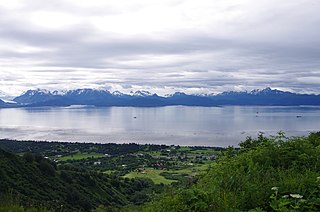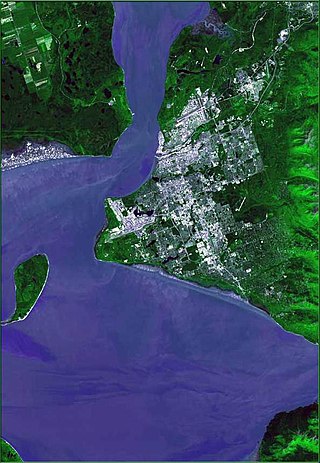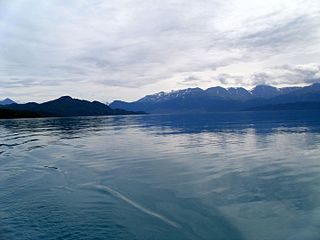Related Research Articles

Kenai Peninsula Borough is a borough of the U.S. state of Alaska. As of the 2020 census, the population was 58,799, up from 55,400 in 2010. The borough seat is Soldotna, the largest city is Kenai, and the most populated community is the census-designated place of Kalifornsky.
Cohoe (Dena'ina: Qughuhnaz’ut) is a census-designated place (CDP) in Kenai Peninsula Borough, Alaska, United States. At the 2010 census the population was 1,364, up from 1,168 in 2000.
Kalifornsky is a census-designated place (CDP) in Kenai Peninsula Borough, Alaska, United States. The population was 8,487 at the 2020 census, up from 7,850 in 2010. It is the most populated locality in the borough.

Kenai is a city in the Kenai Peninsula Borough in the U.S. state of Alaska. It is one hundred and fifty-eight miles by road southwest from Anchorage. The population was 7,424 as of the 2020 census, up from 7,100 in 2010, the fifteenth-most populated city in the state.

Ninilchik is a census-designated place (CDP) in Kenai Peninsula Borough, Alaska, United States. At the 2010 census the population was 883, up from 772 in 2000.

Seward is an incorporated home rule city in Alaska, United States. Located on Resurrection Bay, a fjord of the Gulf of Alaska on the Kenai Peninsula, Seward is situated on Alaska's southern coast, approximately 120 miles (190 km) by road from Alaska's largest city, Anchorage.

Soldotna is a city in the Kenai Peninsula Borough in the U.S. state of Alaska. At the 2020 census, the population was 4,342, up from 4,163 in 2010. It is the seat of the Kenai Peninsula Borough.
Tyonek or Present / New Tyonek is a census-designated place (CDP) in Kenai Peninsula Borough in the U.S. state of Alaska. As of the 2020 census the population was 152, down from 171 in 2010. In 1973, the community formed the Tyonek Native Corporation (TNC) under the Alaska Native Claims Settlement Act and is federally recognized.
Denaʼina, also Tanaina, is the Athabaskan language of the region surrounding Cook Inlet. It is geographically unique in Alaska as the only Alaska Athabaskan language to include territory which borders salt water. Four dialects are usually distinguished:
- Upper Inlet, spoken in Eklutna, Knik, Susitna, Tyonek
- Outer Inlet, spoken in Kenai, Kustatan, Seldovia
- Iliamna, spoken in Pedro Bay, Old Iliamna, Lake Iliamna area
- Inland, spoken in Nondalton, Lime Village

Eklutna is a native village within the Municipality of Anchorage in the U.S. state of Alaska. The Tribal Council estimates the population at 70; many tribal members live in the surrounding communities.

The Kenai Peninsula is a large peninsula jutting from the coast of Southcentral Alaska. The name Kenai is derived from the word "Kenaitze" or "Kenaitze Indian Tribe", the name of the Native Athabascan Alaskan tribe, the Kahtnuht’ana Dena’ina, who historically inhabited the area. They called the Kenai Peninsula Yaghanen.
Kenai may refer to:

Cook Inlet stretches 180 miles (290 km) from the Gulf of Alaska to Anchorage in south-central Alaska. Cook Inlet branches into the Knik Arm and Turnagain Arm at its northern end, almost surrounding Anchorage. On its southern end, it merges with Shelikof Strait, Stevenson Entrance, Kennedy Entrance and Chugach Passage.
Peter Kalifornsky was a writer and ethnographer of the Dena'ina Athabaskan of Kenai, Alaska.

The Denaʼina, or formerly Tanaina, are an Alaska Native Athabaskan people. They are the original inhabitants of the south central Alaska region ranging from Seldovia in the south to Chickaloon in the northeast, Talkeetna in the north, Lime Village in the northwest and Pedro Bay in the southwest. The Denaʼina homeland is more than 41,000 square miles in area. They arrived in the south-central Alaska sometime between 1,000 and 1,500 years ago. They were the only Alaskan Athabaskan group to live on the coast. The Denaʼina have a hunter-gatherer culture and a matrilineal system. The Iditarod Trail's antecedents were the native trails of the Denaʼina and Deg Hitʼan Athabaskan Native Alaskans and the Inupiaq Inuit.

Mount Susitna, also known as Sleeping Lady, (Dena'ina: Dghelishla) is a 4,396-foot (1,340 m) mountain in the U.S. state of Alaska. It is located on the west bank of the lower Susitna River, about 33 miles (53 km) northwest of Anchorage, Alaska. The mountain is a prominent landmark in the Anchorage area and can be seen across the Knik Arm of the Cook Inlet from most of the city, especially at higher elevations.

Fire Island is a 5.5-mile (8.9 km) long island in the U.S. state of Alaska, located near the head of Cook Inlet at 61°09′34″N150°11′55″W. It is the only island in the Municipality of Anchorage, sitting three miles (5 km) off the city's Point Campbell, and nine miles (14.5 km) from downtown. Its land area is 17.467 km2, and there was no permanent resident population at the 2000 census.
James Kari is a linguist and Professor Emeritus with the Alaska Native Language Center at the University of Alaska Fairbanks (UAF) specializing in the Dene of Alaska. For over fifty years he has done extensive linguistic work in many Dene languages including Ahtna, Dena'ina, Koyukon, Deg Hit'an, Holikachuk, Lower Tanana, Middle Tanana, Tanacross, Upper Tanana, and Babine-Witsuwit'en. He was on the faculty of UAF from 1973 until his retirement in 1997. He continues to work on numerous Alaska Native language projects. He is the author or editor of over 200 publications, including more than 4000 pages of bilingual texts in seven Dene languages. He is the most prolific contributor to the Alaska Native Language Archive. His special interest is Dene ethnogeography, and he has compiled or documented more than 14,000 place names in fourteen Alaska or Canadian Dene languages. He worked with Dena'ina writer and ethnographer Peter Kalifornsky on a 1991 compilation of his creative writings. In 2008 he was the organizer of the Dene–Yeniseian Symposium in Alaska, and co-editor of the volume The Dene–Yeniseian Connection published in 2010. In 2009 was selected Kari for the Alaska Governor's Award for the Humanities. In March 2013 Kari received the Professional Achievement Award at the 40th annual meeting of the Alaska Anthropological Association. In 2019 he was presented with a volume of papers by colleagues that recognize his career in Dene research.

Skilak Lake is a large lake on the Kenai Peninsula, Alaska. The lake is part of the Kenai River system but also contains glacial runoff, being fed by meltwater from Skilak Glacier. The water is exceptionally clear with a mostly rocky bottom, relatively free of aquatic vegetation. It is within the Kenai National Wildlife Refuge, and can be accessed by Skilak Lake Loop Road via the Sterling Highway. Maximum depth is 528 feet (161 m), it is 15 miles (24 km) long and up to 4 miles (6.4 km) wide in places. Early Russian explorers mistakenly believed Skilak and Tustumena Lake to be a single body of water. It is a popular destination for Alaskans due to it being only about a half-hour drive from Soldotna, and approximately two hours from Anchorage. There are two campgrounds at the lake, one is a developed campground with a host, the other un-hosted and with only basic facilities. There are many well-developed and maintained trails along the lake and its access road, as well as campgrounds and public-access cabins.
Joan M. Tenenbaum is an American linguist, anthropologist and artist specializing in metalsmithing and jewelry. She is also known for her documentation of the Dena’ina language as for her jewelry pieces which tell the stories of Alaska native peoples and landscape.
References
- Boraas, Alan. (1975). "Report on the 1975 Excavations at the Kalifornsky Village Site, Kenai Peninsula, Alaska." Unpublished manuscript in author's files.
- Boraas, Alan S. (1991). "Peter Kalifornsky: A Biography." In Kalifornsky (1991), pp. 470–481.
- Boraas, Alan S., compiler. (ca. 2000). Dena'ina Language Guide. University of Alaska Anchorage, Department of Anthropology. Retrieved on 2007-02-25. Compiled by Alan Boraas based on linguistic data compiled by Joan Tenenbaum.
- Dixon, R. Greg, James M. Kari, Alan Boraas, eds. (2005-12-12). Bibliography of Sources on Dena’ina and Cook Inlet Anthropology, ver. 2.4. Kenai, AK: Kenaitze Indian Tribe, Ts'itsatna Tribal Archives. Retrieved on 2007-02-25.
- Kalifornsky, Peter. (1991). A Dena'ina Legacy — K'tl'egh'i Sukdu: The Collected Writings of Peter Kalifornsky. Ed. by James Kari and Alan Boraas. Fairbanks, AK: Alaska Native Language Center, University of Alaska Fairbanks.
- Kenai Peninsula College, University of Alaska Anchorage. Faculty Register. Retrieved on 2007-02-25.
- Kizzia, Tom. (1993-06-07). "Kenaitze Elder, Storyteller Dies: Peter Kalifornsky Nursed Old Ways." Anchorage Daily News, p. A1.
- Kizzia, Tom. (1993-06-10). "Dena'ina Elder Buried in Once-Lost Cemetery," Anchorage Daily News, p. A1.
- Loshbaugh, Doug. (2000-03-05). "Digging the Past." Peninsula Clarion. Retrieved on 2007-02-26.
- Michels, Jacki. (2002-12-17). "Alaskan Advantage: An Interview with Archeology Professor Alan Boraas." The KPC Connection. Retrieved on 2007-02-26. (Scroll down and follow link)